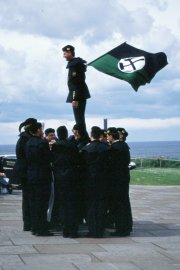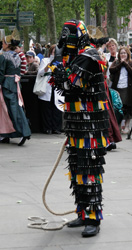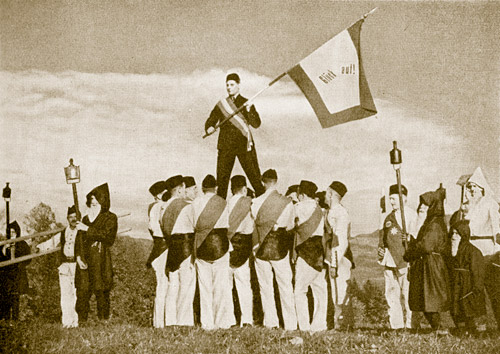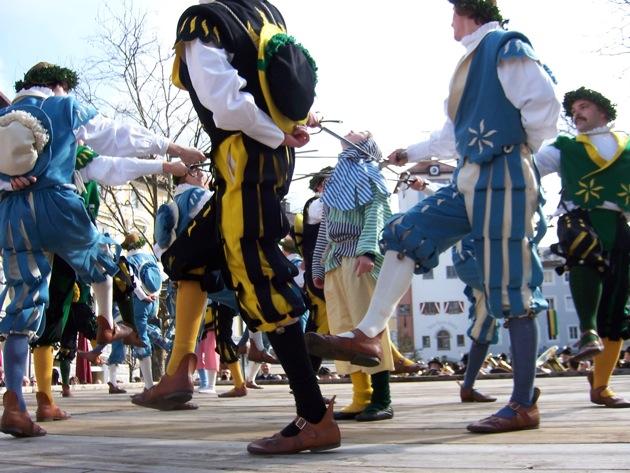Sword dances from
Germany, Austria & Switzerland
There are various sword dances known to have existed in Germany, Austria and German-speaking Switzerland. These dances are among the oldest: sword dances performed by the Guilds of Smiths and Cutlers in Nuremberg were first recorded in 1350, there are records of sword dances in Brunswick and Cologne prior to 1500, and records of dances all over Germany in the 16th century. There are paintings of sword dances in Zürich in 1578 and in Nuremberg in 1600. The side from Überlingen in Germany, first recorded in 1646, but possibly dating back to 1538, is the oldest sword dance side still in existence.

The Nuremberg Cutlers Guild dance from ca 1600
The dances are generally similar to longsword dances, but generally with simpler figures and add elements such as elevating a captain on a lock of swords. The dances were usually performed by members of Guilds, who often had special dispensations from local authorities to allow them to perform the dance. In some parts of Germany and Austria, the sword dance was a special privilege permitted only to miners, as miners were uniquely permitted to carry swords for protection with many mines being in remote mountain areas.

Sword dances in German-speaking countries often include flag waving routines, and in some cases the “leader” of the group is lifted up on a lock to wave the flag. In Austrian miners' dances, the leader may also give a traditional speech.
The Germanic sword dance traditions, according to the Austrian ethnologist Richard Wolfram, almost always include the symbolic death and reawakening of one of the participants. There is some belief from the 8th century writings of the Venerable Bede and 19th century research by Jakob Grimm, but little explicit evidence, that sword dances were part of the springtime rites for the Teutonic pagan goddess of fertility Ostara (also known as Eostre) – after whom Easter is named – in which the death and reawakening sequences might have had ritual importance.
Überlingen sword dance
Überlingen lies in the southwest of Germany and claims the oldest continuously performed sword dance, whose existence was first specifically recored in 1646. It was the preserve of the Vintners' Guild, which is first mentioned in 1538, a date which has been claimed as the date of foundation of the team.
The sword dance was originally performed by the Vintners as part of the town's Shrovetide celebrations, but was later moved to the Schweden Prozession, an annual celebration on the second Sunday of July of the town's successful defence against the Swedish army during the Thirty Years War. The Schweden Prozession starts with a Mass at the cathedral, followed by a two hour procession, another Mass, and the performance of the sword dance first in the main square then in front of the cathedral.

Prior to the procession, the team meet for a breakfast of local sausages and water, and the team's fool, the Hänsele is symbolically thrown out. The Hänsele is masked, wears a black costume with rags of brightly coloured cloth and bells, and carries a whip; he is traditionally banned from speaking to the other dancers and does not attend Mass. Legend has it that in the past the town raised an army to defend its traditional freedoms against the Holy Roman Emperor, and all the troops attended a Mass before leaving, except one man (Hänsele) who went to the pub instead and was the only man killed in the battle. The Hänsele character also appears in other local customs associated with the Fasnacht carnival at Shrovetide.
The tradition has been kept alive by the Überlinger Schwerttanzkompanie, which maintains its own records back to 1892, and was refounded in the early 1950s after permission was given to carry swords (otherwise prohibited by a general ban on carrying arms in post-War Germany). Membership is strictly controlled, in the spirit of the rules of the Vintner's Guild, and considered to be a great honour.
The dancers wear costume based on formal attire from the eighteenth century, with triangular hat, dark blue frock coat, red waistcoat, white shirt with wing collar and bow-tie, black breeches and black shoes with large silver buckles. A sprig of rosemary is worn in the left lapel – reputedly so that its smell would wake any dancer who fell asleep during Mass!

The dance itself is peformed by linking up in a chain, but not in a closed circle as in rapper or longsword. The chain then performs some figure-of-eight manoeuvres, then a figure where the dancers pass repeatly under an arch formed by a sword, with the last dancer adding his sword to the arch each time until all the dancers are included and the swords have formed a mesh. The Hänsele character then stands under the centre of the mesh and the dancers cheer while circling around him (possibly an evolved form of the mock execution found in other sword dances). There are then simple single-over and single-under type figures. At the end of the sword dance, the dancers take partners from the women in traditional dress who follow the procession and perform a sequence of couples dances.
Dürrnberg sword dance
The Dürrnberg sword dance, from near Hallein in Austria, is a special example, first recorded in 1586; it was traditionally performed exclusively by salt miners, and has a number of complex figures representing actions performed in salt mining, such as climbing ladders of swords, passing through a “mine gallery” of swords and bucket lifting.

In common with many other European sword dances, the Dürrnberg sword dancers elevate their leader on a lock, where he gives a traditional speech, but the dance also includes a figure, called Haldensturz, where an upper tier of dancers stand on the backs of those below them; the two tier figure is very rare in linked sword dances with the Perth Glovers' dance as well as some dances from Galicia and the Minho province of Portugal being the other examples known.
The dance is known to have evolved considerably in its history, with performances lasting around 90 minutes in the 16th and 17th century, and being shortened to 45 minutes in the 19th century. The whole performance now includes a band of 50 musicians, flag bearers and 20 dancers.
Traunstein sword dance
The former salt-mining town of Traunstein, in the south-east of Bavaria close to Berchtesgaden, and therefore not far from Dürrnberg, is the home to a sword dance still performed today. The first record of the sword dance in Traunstein comes from a ledger in the town records detailing payment of 1 guilder to the sword dancers for a performance in 1530.
Over the years the dance died out locally, but the 1530 reference was discovered in 1922 by Dr. Georg Schierghofer, a local pharmacist who was re-organising the town archives. He then arranged for the dance to be reconstructed in time for a performance at the town's 800th anniversary in 1926. This reconstruction was achieved by the Turnverein Traunstein in 1925.
The choreography of the reconstructed dance was developed by Frank Absmeier, the song by Irma Peetz, and the costume designed by Prof. Wolfgang Quincke, who based it on the clothing worn locally in the 16th century.

The dance includes both linked and mock combat figures, the mock execution of a fool, so common in German sword dances, as well as the elevation of a dancer on a lock of swords. It is said to celebrate spring driving out the winter, and is performed during the Georgiritt, a traditional South German festival celebrating St. George, which traditionally takes place in Traunstein on Easter Monday.

After the inevitable hiatus caused by the war, the Traunstein sword dance has been performed at the Georgiritt every year since 1948.
Other linked dances

The German speaking countries also have a variety of linked dances using hoops or garlands rather than swords, such as the famous Schäfflertanz performed at carnival time once every seven years since 1760 by members of the Guild of Coopers in Munich as thanksgiving for the end of a local plague epidemic (their next performance will be in 2012). The dance performed by mechanical figures features on the Glockenspiel of the Munich City Hall (see photograph).
Another linked dance was that of the iron miners of Hüttenberg in Carinthia, Austria, traditionally performed at the Laubhüttenfest on the first Sunday after Pentecost. From Wolfram's description, this traditional performance started with a parade of the entire workforce of the iron mine in decorated uniforms, then forming a marching circle around a waving flag; a fool comes forward and gives a traditional calling-on speech, then twenty-five dancers in a linked row perform over and under figures; the last dancer in the chain, called the “Schwoafträger” is enclosed and falls to the ground as if dead then is revived by a touch of the fool's wand.
Sword dance and Nazi ideology
Unfortunately, during the 1930s in Germany, there was increased interest in sword dancing by the National Socialists and their sympathisers, and much nationalistic comment was made about them. Earlier, in the 19th century, various nationalistic German authors asserted that the sword dancing was Germanic in origin, citing the reference to sword dancing from the Roman author Tacitus's Germania in support of their claims. The Austrian ethnologist Richard Wolfram (a member of the Nazi party) wrote in his 1937 book Deutsche Volkstänze that the sword dance was originally performed by all Germanic peoples, including the English and Scandinavians, and not by any others – presenting as bold fact a theory without supporting evidence. The Nazis exploited these to assert that the sword dance was “proof” of the supposed German racial superiority and a symbol of Aryan unity.
Hans von der Au and Bernhard von Peinen published Deutscher Schwerttanz in 1935, describing a model sword dance based on the elaborate dance performed by ethnic Germans in Sibiu (Hermannstadt) in Romania. The authors suggested the dance be performed by the party's storm troops and the SS. Further discussion of this is available in Steve Corrsin's excellent article Sword Dances of the NSDAP, published in the American Morris Newsletter in 2006.
Links
Bibliography
Violet Alford, Sword Dance and Drama, London: Merlin Press, 1962
Aenne Goldschmidt, Handbuch des deutschen Volkstanzes, 6th ed, Stuttgart: Walter Kügler Verlag, 2001
Kurt Meschke, Schwerttanz und Schwerttanzspiel im Germanischen Kulturkreis, Berlin, 1931
Karl Mullenhoff, Über den Schwerttanz, Berlin, 1871
Herbert Oetke, Der deutsche Volkstanz, Berlin: Henschelverlag, 1982
Trevor Stone, The Überlingen Sword Dance Ceremony, Rattle Up My Boys 1995; 5(4):1-5.
Richard Wolfram, Schwerttanz und Männerbund, Kassel, 1935
Richard Wolfram, Die Volkstänze in Österreich und verwandte Tänze in Europa, Salzburg, 1951
Kurt Zinnburg, Der Schwerttanz der Dürrnberger Bergknappen, Salzburg: Salzburger Druckerei, 1981.
The photographs of the Traunstein sword dancers on this page are by Alexander Ostermeyer and were sourced from the Wikipedia pages on Schwerttanz, and are copied under the terms of the Creative Commons Attribution-Share Alike 3.0 licence. The photographs may therefore be freely copied for use elsewhere as long as the source is thus credited and the same terms applied.
